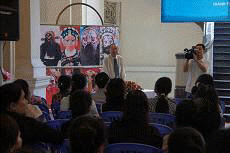On the morning of May 31, 2011, at the Museum of Ho Chi Minh City, a talk on “Conventionality in the art of Hat Boi” was presented by People’s Artist Dinh Bang Phi. People’s Artist Dinh Bang Phi has more than 50 years of passion and commitment to the Hat Boi art stage. And with significant contributions in composing and summarizing the Hat Boi stage, he is considered one of the few researchers of Hat Boi in the South. In the talk, there were performances of illustrated excerpts from Hat Boi by artists from Ho Chi Minh City’s Hat Boi Art Theater.
On the leadership side, there was the presence of Ms. Pham Duong My Thu Huyen – Director of the City Museum representing the city’s Department of Culture, Sports and Tourism. Ms. Phan Ngoc Nga – Deputy Director of the City Opera House. Together with representatives of cultural centers of districts, professional staff of museums in the city, and a large number of students from the University of Culture, Open University, University of Social Sciences and Humanities City College of Culture and Arts.
Hat Boi is a long-standing traditional art form in Vietnam. Following the Vietnamese exiles who went to reclaim the new land more than 300 years ago, Hat Boi gradually shaped and developed and became a cultural activity closely associated with the people of the South. Over time, the art of Hat Boi – which is considered as the scholarly art of the nation – still has a lasting vitality in it.
People’s Artist Dinh Bang Phi said:
At the beginning of the fourteenth century, Vietnamese dukes wrote the first opera, “Tay Vuong Mau giving table peaches”, and performed it in the Tran court. Since then, singing boi was recognized and because it was performed only on important occasions of the court, it was also known as “court singing”. However, because of its popularity, it has crossed the above boundary to enter the folk with famous plays such as “Phung Nghi Dinh”, “Clam, oyster, snail, mussel”…
As a highly conventional art, singing boi requires a dual training of acting talent. Studying and adapting, being breathed in by Vietnamese artists with a strong national spirit, singing boi quickly appeared in both the Inner and Outer regions as a premier stage form. From the kings and mandarins to the common people, singing boi served the entertainment and learning needs, and even influenced the way people think and behave in society. People often say to each other: “Hot like Truong Phi”, “Crying like Liu Bei” and “doubtful like Cao Cao”…
Today, the presence of singing boi in the communal house is no longer present, but its echoes are still subtle in this river region. Singing Boi has brought a strong vitality, not only entertainment, but residents also find in it benevolent lessons. Boi singing in the communal house has created a playground, a rendezvous for the river community, where the chiefs of the regions meet and tighten the bonds of solidarity. This art form also invigorates people to believe and love this land more.
Masquerade art:
The art of masquerade mask singing boi inherently describes the appearance of characters in a symbolic form, actors have to spend a lot of effort learning to know how to apply makeup, draw masks for themselves according to each role, each character type.
In order to sharply express the winding lines in the art of masked singing, the materials used must be made through an elaborate process.
For example, in order to get a black jar to paint eyebrows and eyes, artists have to create this powder themselves by burning an oil lamp, above the lamp there is an upside down tin can to catch the dust of the lamp.
Nowadays, on the market, there are many types of good quality cosmetics, so the problem of the ingredients used to disguise the actors’ masks is also richer.
A little “secret” to understand and recognize the characters on the stage singing boi: the background of the face is vermilion, indicating the hero’s virginity; moldy white color is a deceitful, flatterer; the black color of a straightforward person, hot-tempered but upright and honest; pale gray is an old person; blue refers to cunning conspirators, demons…
Drawing circles around the eyes also have many different meanings: diagonal lenses are martial arts, children (children of the general’s family), and vertical lenses are martial generals. The face painted with many camouflages is a villain, a bandit, and a lover of religion.
On his forehead is drawn an eye that is a person with wisdom eye, seeing far and wide. Silky-bladed eyebrows are macho guests, short eyebrows are crooks, fiery eyebrows indicate hot-tempered people… Beards of 3 clusters, 5 constellations (black, silver) indicate gentle, calm, noble people.
Twisted blackbeard is a fierce, hot-tempered person. Cut beard (black, red) is a person with a sense of humor. Mouse whiskers indicate people who are quick, people who are snappy. Particularly, the continuous beard has 3 colors: black – flatterer, silver – heroic general, red – traitor general, love religion, witch.

